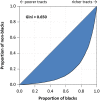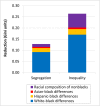For blacks in America, the gap in neighborhood poverty has declined faster than segregation
- PMID: 27821759
- PMCID: PMC5127296
- DOI: 10.1073/pnas.1607220113
For blacks in America, the gap in neighborhood poverty has declined faster than segregation
Abstract
Black residential segregation has been declining in the United States. That accomplishment rings hollow, however, if blacks continue to live in much poorer neighborhoods than other Americans. This study uses census data for all US metropolitan areas in 1980 and 2010 to compare decline in the neighborhood poverty gap between blacks and other Americans with decline in the residential segregation of blacks. We find that both declines resulted primarily from narrowing differences between blacks and whites as opposed to narrowing differences between blacks and Hispanics or blacks and Asians. Because black-white differences in neighborhood poverty declined much faster than black-white segregation, the neighborhood poverty disadvantage of blacks declined faster than black segregation-a noteworthy finding because the narrowing of the racial gap in neighborhood poverty for blacks has gone largely unnoticed. Further analysis reveals that the narrowing of the gap was produced by change in both the medians and shapes of the distribution of poverty across the neighborhoods where blacks, whites, Hispanics, and Asians reside.
Keywords: Gini index; neighborhood poverty; racial inequality; residential segregation.
Conflict of interest statement
The authors declare no conflict of interest.
Figures








References
-
- Reardon SF, Fox L, Townsend J. Neighborhood income composition by household race and income, 1990-2009. Ann Am Acad Pol Soc Sci. 2015;660:78–97.
-
- Logan JR. Separate and Unequal: The Neighborhood Gap for Blacks, Hispanics and Asians in Metropolitan America. Project U.S. 2010 Report. Russell Sage Foundation; New York: 2011.
-
- Reardon SF, Bischoff K. Income inequality and income segregation. AJS. 2011;116(4):1092–1153. - PubMed
-
- Jargowsky PA. Poverty and Place: Ghettos, Barrios, and the American City. Russell Sage Foundation; New York: 1997.
Publication types
MeSH terms
Grants and funding
LinkOut - more resources
Full Text Sources
Other Literature Sources
Miscellaneous

